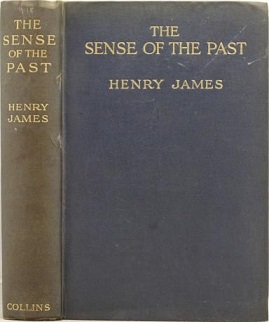The Sense of the Past

The cover of first edition
|
|
| Author | Henry James |
|---|---|
| Country | United Kingdom, United States |
| Language | English |
| Genre | Novel |
| Publisher | W. Collins Sons & Co., London Charles Scribner's Sons, New York City |
|
Publication date
|
Collins: 6-Sept-1917 Scribner's: 26-Oct-1917 |
| Media type | Print (Hardback & Paperback) |
| Pages | Collins: 351 pp Scribner's: 358 pp |
The Sense of the Past is an unfinished novel by the American author Henry James that was published in 1917, a year after James' death. The novel is at once an eerie account of time travel and a bittersweet comedy of manners. A young American trades places with a remote ancestor in early 19th century England, and encounters many complications in his new surroundings.
Young Ralph Pendrel of New York City has written a fine essay on the reading of history. The essay so impresses a distant English relative that he bequeaths an 18th-century London house to Ralph. Pendrel goes to London and explores the house thoroughly. He feels himself going back in time as soon as he crosses the threshold. He finds a portrait of a remote ancestor, also named Ralph Pendrel. The portrait comes alive and the two men meet.
Later, the modern-day Pendrel goes to the U.S. ambassador in London and tries to tell him of these strange occurrences. He then returns to the mysterious house, steps across the threshold, and finds himself in the early 19th century. At this dramatic juncture, the part of the novel that James wrote in 1900 breaks off. James resumed the novel in 1914 with scenes of Ralph meeting his ancestor's relatives, as he has taken the other's place. He finds that he is engaged to one of those relatives, Molly Midmore, but realizes that he is attracted to her sister Nan. He also meets Molly's mother and unpleasant brother, and Nan's suitor, Sir Cantopher Bland.
The novel breaks off completely here. James left extensive notes on how the novel would continue: Nan would eventually realize that Ralph is actually a time-traveller from the future; she would sacrifice her own happiness to help him return to his own time and to Aurora Coyne, a woman who had previously rejected Ralph but would now accept him.
James was generally not interested in long-ago eras. At most he was attracted by a more recent, "visitable" past. His preference for present-day reality is shown in the fact that the story would have ended with Ralph triumphantly returning from the early 19th century to his own time. Whether James could have managed the details of Ralph's trip through the past and return to the present is problematic; he abandoned the novel in 1900 because the material was becoming too intractable and convoluted.
James' renewed effort in 1914 to complete the story does not reassure the reader that the aging master was up to the formidable demands of the time-travel storyline. He allowed scenes to ramble far too long, and he appears to have lost the ability to impose much-needed order on his material. If he had completed the writing, The Sense of the Past might have become a brilliant, subtle exploration of the influence of the past on the present, but it is impossible to judge a novel that was left unfinished.
...
Wikipedia
